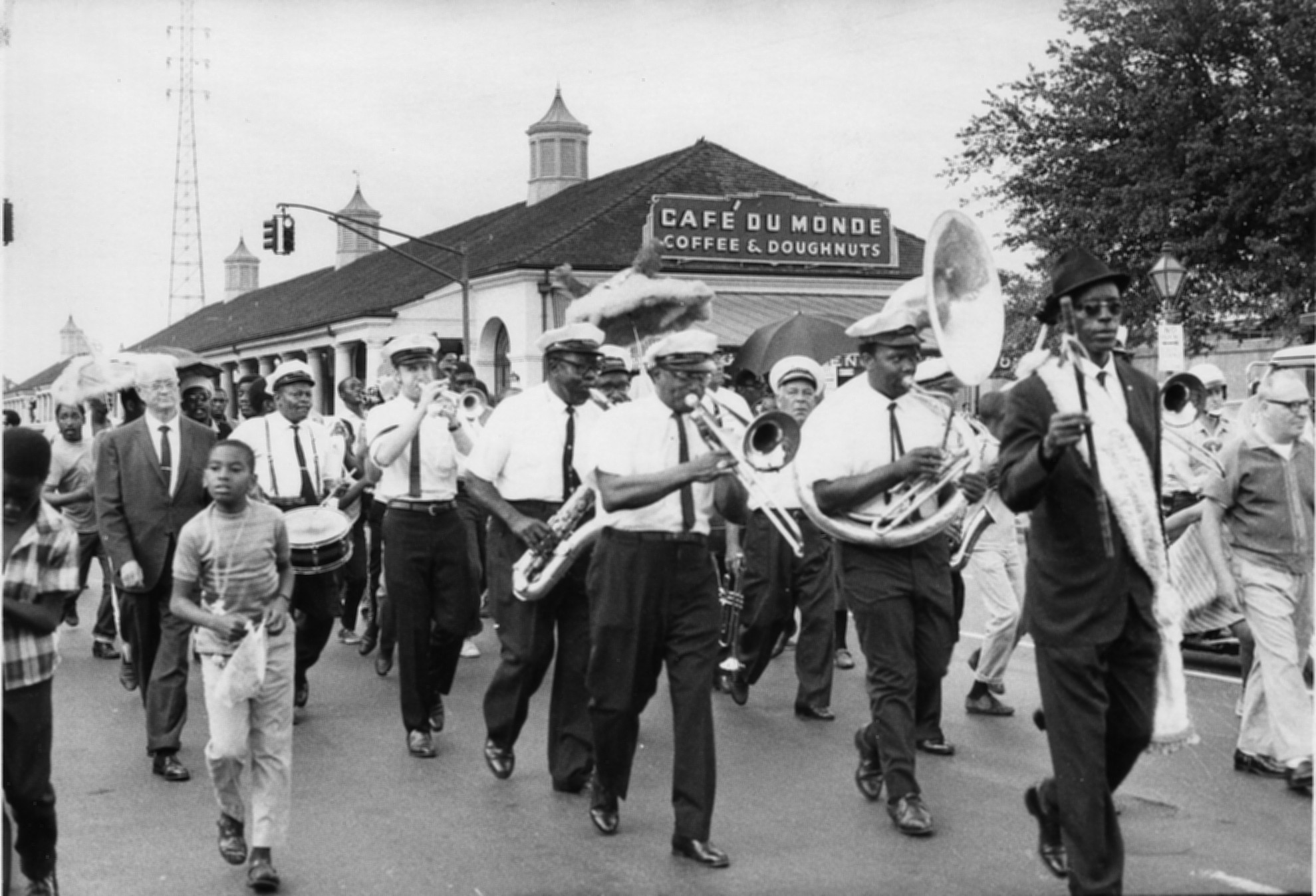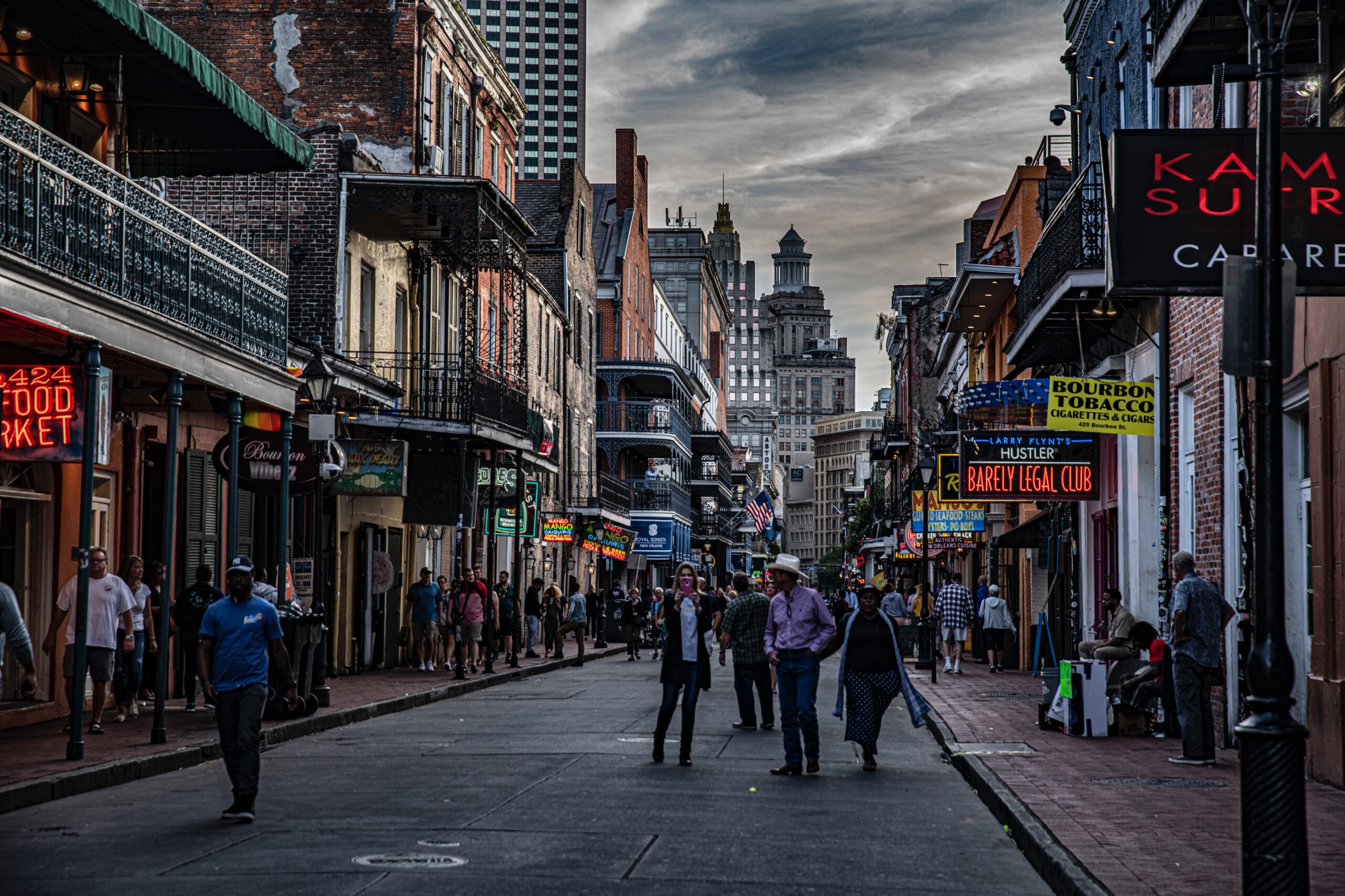As a melting pot of culture and a place that perpetuates production of local difference, local cultures, and different local histories, New Orleans has always appealed to visitors’ taste for the exotic and unique. As a result, the city has long been subjected to tourism as visitors from around the globe flock to immerse themselves in the culture. Around the turn of the 20th century, the birth of Jazz brought musical legends like Louis Armstrong and Buddy Bolden to the city where they nurtured their talents. The Jazz Age in New Orleans also saw the rise of a literary and artistic community. Many notable American writers such as William Faulkner, Truman Capote, and Tennessee Williams came to the French Quarter for its freewheeling urban environment and creative stimulus. It was during this time in the early 20th century that the far more gentrified French Quarter of today was home to many families.

New Orleans Jazz Age
Halfway through the century, however, the struggle of the civil rights movement would persist. Although technically legal and civil equality had be reestablished by the end of the 1960s, there were large gaps in income levels and education attainment between the city’s black and white populations. As New Orleans became proportionately more African American, the 1980s saw officials elected from that community. As these officials struggled to narrow the income gap, New Orleans became increasingly dependent on tourism. With low levels of educational attainment and high rates of poverty and crime, the city’s focus on tourism became detrimental to the neighborhoods that are cultural hubs in New Orleans, particularly the French Quarter.
When it comes to tourism, however, it is precisely the rich culture and historic neighborhoods that have always brought in visitors. In 2004, just one year prior to Katrina, New Orleans saw over 10 million visitors spend some $5 billion. That number plummeted to under 4 million visitors spending $2.8 billion. With major chains such as Virgin and Ace Hotels beginning to develop near the French Quarter, it was clear the focus was still on tourism. Additionally, ghost tours and daquiri shops began over running the streets, as art galleries, antique stores, and local shops were pushed out. As a result, the culture in New Orleans’s most historic neighborhood is being destroyed. Having previously been reliant on tourism, after Katrina, New Orleans had nearly nothing else to rely on. This time, however, the devastated city lost a large percentage of its population, as many people who evacuated never returned. Even today some neighborhoods have yet to fully recover. This movement lead to another change in the city within the real estate market, having yet another effect on the families that have been longtime residents in historic areas.
Once home to large extended families living in tenements, the far more gentrified French Quarter of today is mainly comprised of single-family homes and condo rental units. With fewer places for families to live and a lack of apartment housing, the population of the Quarter has decline from about 20,000 residents in the 1920s to about 4,000 residents now. Reliance on tourism pre and post Katrina has caused a once family oriented neighborhood to be over-run by the same few attractions. In addition, the number of Airbnb properties spiked from just under 2,000 in 2015 to over 6,500 in 2018. This has the effect of converting once historic blocks into hotels. Low housing prices after Katrina kept investors coming to New Orleans seeking financial gain, and began buying up houses for short term rentals, turning the French Quarter from a family-oriented and cultural significant neighborhood into a weekend party destination.

French Quarter Recent Years
With more money in the area, more changes were made which altered the neighborhood even further. Quarter residents approved a hike in sales tax to pay for more police presence in the area. However, that benefit comes at the cost of a specific group of residence living in the French quarter. The tax then creates a high cost of living in the area, which is not the same as implementing a federal or state tax that would improve public services for everyone. Also in 2015, the city of New Orleans banned smoking in bars and restaurants. This change could improve your experience in New Orleans, but one must admit that it has a great impact on the ambience of the French Quarter. Although the increase police presence has helped clean the streets of the drugs and prostitutes that were once blended with the cityscape, one local journalist points out that these were only commonalities back when families actually lived in the French Quarter. The grittiness that is embedded within the area is being cleaned up for the incoming tourists. But it’s that very grittiness that gives New Orleans its character. The irony there is that there were more families and children running around in the Quarter when smoking in establishments was allowed, drugs were running rampant, and prostitution was far more public. For the families that remain, the over-commercialization of the Quarter has destroyed the very characteristics of the neighborhood that make it so beloved. With an ever-increasing tide of tourists, all that seems to remain of the historic area are ghost tours and never-ending parties.
 NOLAbeings
Multimedia artist Claire Bangser created NOLAbeings as a portrait-based story project that marries...
NOLAbeings
Multimedia artist Claire Bangser created NOLAbeings as a portrait-based story project that marries...
 Data corner: Adobe Suite (create a PDF, social media graphic, presentation, edit a photo and video
Data corner is where you go to work with analytics and top tech skills. It takes on everything from PERL and SQL to Canva and Sprout Social.
Data corner: Adobe Suite (create a PDF, social media graphic, presentation, edit a photo and video
Data corner is where you go to work with analytics and top tech skills. It takes on everything from PERL and SQL to Canva and Sprout Social.
